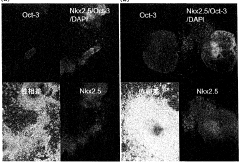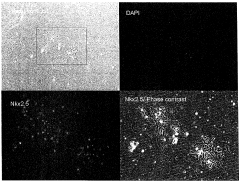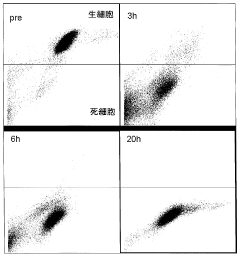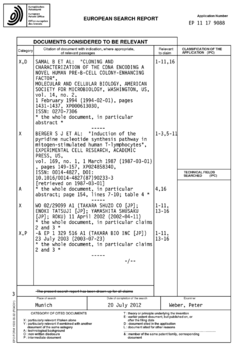Hypertonic Methods in Overcoming Cellular Stress Responses
Hypertonic Methods Background and Objectives
Hypertonic methods have emerged as a promising approach in cellular biology, particularly in addressing cellular stress responses. The field has evolved significantly over the past few decades, driven by the need to understand and manipulate cellular behavior under various environmental conditions. Initially, research focused on the effects of osmotic stress on cell physiology, but it has since expanded to encompass a wide range of applications in biotechnology and medicine.
The development of hypertonic methods can be traced back to early observations of cell shrinkage in hypertonic solutions. As researchers delved deeper into the mechanisms underlying these responses, they uncovered complex signaling pathways and adaptive strategies employed by cells to maintain homeostasis. This led to a paradigm shift in how we view cellular stress responses and opened up new avenues for therapeutic interventions.
One of the key objectives in this field is to harness the potential of hypertonic conditions to modulate cellular functions. By carefully controlling the osmotic environment, researchers aim to influence gene expression, protein folding, and metabolic processes. This has far-reaching implications for drug delivery, cryopreservation, and the treatment of various diseases, including cancer and neurodegenerative disorders.
Recent technological advancements have significantly enhanced our ability to study and manipulate cellular responses to hypertonic stress. High-throughput screening methods, advanced imaging techniques, and computational modeling have enabled researchers to gain unprecedented insights into the molecular mechanisms at play. These tools have also facilitated the development of more targeted and effective hypertonic treatments.
The current research landscape is characterized by a multidisciplinary approach, combining insights from cell biology, biophysics, and bioengineering. Scientists are exploring novel osmolytes, investigating the role of membrane transporters, and developing sophisticated delivery systems for hypertonic agents. The ultimate goal is to create tailored solutions that can selectively target specific cell types or cellular processes while minimizing undesired side effects.
As we look to the future, the field of hypertonic methods in overcoming cellular stress responses is poised for significant breakthroughs. Emerging areas of focus include the development of smart materials that can respond dynamically to changes in osmotic pressure, the integration of hypertonic approaches with other therapeutic modalities, and the application of artificial intelligence to predict and optimize cellular responses to hypertonic conditions.
Market Analysis for Hypertonic Therapies
The market for hypertonic therapies is experiencing significant growth, driven by the increasing prevalence of cellular stress-related disorders and the growing demand for innovative treatment approaches. Hypertonic solutions, which have higher solute concentrations than physiological fluids, are gaining traction in various medical applications, particularly in addressing cellular stress responses.
The global market for hypertonic therapies is projected to expand at a steady pace over the next five years. This growth is primarily attributed to the rising incidence of conditions such as sepsis, traumatic brain injury, and various inflammatory disorders where cellular stress plays a crucial role. Additionally, the aging population and the increasing prevalence of chronic diseases are contributing to the market's expansion.
North America currently holds the largest market share, followed by Europe and Asia-Pacific. The United States, in particular, is a key market due to its advanced healthcare infrastructure and high healthcare expenditure. However, emerging economies in Asia-Pacific, such as China and India, are expected to witness the fastest growth rates in the coming years, driven by improving healthcare access and increasing awareness of advanced treatment options.
The market is segmented based on application areas, including critical care, neurology, oncology, and others. Critical care applications, particularly in the management of sepsis and acute respiratory distress syndrome, currently dominate the market. However, neurological applications, such as the treatment of traumatic brain injury and stroke, are expected to show the highest growth rate in the forecast period.
Key players in the hypertonic therapies market include pharmaceutical companies, biotechnology firms, and medical device manufacturers. These companies are investing heavily in research and development to create more effective and targeted hypertonic solutions. Collaborations between academic institutions and industry players are also driving innovation in this field.
The market is characterized by a high degree of competition, with companies focusing on product differentiation and expanding their geographical presence. Mergers and acquisitions are common strategies employed by larger companies to strengthen their market position and expand their product portfolios.
Regulatory factors play a crucial role in shaping the market landscape. Stringent approval processes for new therapies can pose challenges for market entry but also ensure the safety and efficacy of products reaching the market. As research in cellular stress responses advances, it is anticipated that regulatory bodies will develop more specific guidelines for hypertonic therapies, potentially streamlining the approval process for novel treatments.
Current Challenges in Cellular Stress Management
Cellular stress management remains a critical challenge in biological research and medical applications. The current landscape of cellular stress responses presents several significant hurdles that researchers and clinicians must overcome to develop effective treatments and interventions.
One of the primary challenges is the complexity and diversity of cellular stress responses. Cells can experience various forms of stress, including oxidative stress, heat shock, osmotic stress, and endoplasmic reticulum stress. Each type of stress triggers distinct molecular pathways and adaptive mechanisms, making it difficult to develop a one-size-fits-all approach to stress management.
The dynamic nature of stress responses further complicates the issue. Cellular stress can rapidly escalate, leading to a cascade of events that may result in cell death if not properly managed. This time-sensitive aspect poses significant challenges in developing interventions that can be administered quickly and effectively to mitigate stress-induced damage.
Another major obstacle is the delicate balance between protective and harmful stress responses. While moderate stress can activate adaptive mechanisms that enhance cellular resilience, excessive or prolonged stress can overwhelm these protective systems and lead to cellular dysfunction or death. Determining the optimal level of stress intervention to promote beneficial adaptations without causing harm remains a significant challenge.
The heterogeneity of cellular populations within tissues and organs also presents difficulties in stress management. Different cell types may exhibit varying sensitivities to stress and respond differently to interventions. This variability necessitates the development of targeted approaches that can address the specific needs of diverse cell populations within complex biological systems.
Furthermore, the interconnectedness of stress response pathways creates challenges in isolating and modulating specific stress mechanisms. Interventions targeting one pathway may have unintended consequences on other cellular processes, potentially leading to adverse effects or reduced efficacy of treatments.
The translation of in vitro findings to in vivo applications represents another significant hurdle. Cellular stress responses observed in controlled laboratory conditions may not accurately reflect the complex interactions and environmental factors present in living organisms. This gap between laboratory research and clinical applications necessitates extensive validation and refinement of stress management strategies.
Lastly, the development of reliable biomarkers and diagnostic tools for assessing cellular stress levels in real-time remains an ongoing challenge. Without accurate and timely measurements of stress status, it becomes difficult to tailor interventions and monitor their effectiveness in managing cellular stress responses.
Existing Hypertonic Solutions
01 Hypertonic solutions for inducing cellular stress responses
Hypertonic solutions can be used to induce cellular stress responses, which may have therapeutic applications. These solutions create an osmotic imbalance, triggering various cellular mechanisms to maintain homeostasis. This approach can be utilized in studying stress responses and developing potential treatments for various conditions.- Hypertonic solutions for inducing cellular stress responses: Hypertonic solutions can be used to induce cellular stress responses, which can be beneficial for studying various physiological processes. These solutions typically contain high concentrations of solutes, creating an osmotic gradient that causes water to leave cells, leading to cellular stress. This method can be used to investigate cellular adaptation mechanisms and stress-induced gene expression.
- Cellular stress response in cryopreservation: Hypertonic methods can be applied in cryopreservation techniques to induce cellular stress responses that protect cells during freezing and thawing processes. By exposing cells to hypertonic conditions before freezing, they can activate stress response pathways that enhance their survival during cryopreservation. This approach is particularly useful in preserving various cell types and tissues for research and medical applications.
- Measurement and analysis of cellular stress responses: Various methods and devices have been developed to measure and analyze cellular stress responses induced by hypertonic conditions. These include high-throughput screening techniques, gene expression profiling, and advanced imaging methods. Such tools allow researchers to quantify and characterize the cellular stress response, providing insights into cellular adaptation mechanisms and potential therapeutic targets.
- Therapeutic applications of hypertonic stress-induced responses: The cellular stress responses induced by hypertonic methods can be harnessed for therapeutic purposes. These applications include developing treatments for various diseases, enhancing drug delivery systems, and improving wound healing processes. By understanding and manipulating the cellular stress response, researchers can develop novel approaches to address a wide range of medical conditions.
- Cellular stress responses in biotechnology and agriculture: Hypertonic methods for inducing cellular stress responses have applications in biotechnology and agriculture. These techniques can be used to enhance crop resistance to environmental stresses, improve biofuel production, and develop more efficient fermentation processes. By leveraging cellular stress responses, researchers can optimize various biological processes for industrial and agricultural applications.
02 Cellular stress response pathways in hypertonic conditions
Research focuses on understanding the specific cellular pathways activated under hypertonic stress. This includes the study of signaling cascades, gene expression changes, and protein modifications that occur when cells are exposed to hypertonic environments. Identifying these pathways can lead to novel therapeutic targets and strategies.Expand Specific Solutions03 Hypertonic methods for enhancing drug delivery
Hypertonic solutions can be used to enhance the delivery of therapeutic agents to cells. The osmotic stress induced by these solutions can increase cell membrane permeability, allowing for improved uptake of drugs or other compounds. This approach has potential applications in various fields, including cancer treatment and gene therapy.Expand Specific Solutions04 Protective effects of hypertonic solutions against cellular stress
Certain hypertonic solutions have been found to have protective effects against various forms of cellular stress, including oxidative stress and inflammation. These solutions may activate cellular defense mechanisms or alter gene expression patterns to enhance cell survival under stressful conditions. This research has implications for treating conditions associated with cellular stress and damage.Expand Specific Solutions05 Hypertonic methods in cryopreservation and cell culture
Hypertonic solutions play a crucial role in cryopreservation techniques and cell culture methods. These solutions can help protect cells from damage during freezing and thawing processes, as well as optimize cell growth and maintenance in culture. Understanding the cellular stress responses in these contexts can lead to improved protocols for cell preservation and cultivation.Expand Specific Solutions
Key Players in Hypertonic Research
The research on hypertonic methods in overcoming cellular stress responses is in an emerging stage, with growing market potential as cellular therapies gain prominence. The global market for cell therapy technologies is expanding rapidly, expected to reach significant value in the coming years. Technologically, the field is still developing, with varying levels of maturity among key players. Leading institutions like The Regents of the University of California, Harvard College, and Beth Israel Deaconess Medical Center are at the forefront, conducting advanced research. Companies such as Daiichi Sankyo and S-ALPHA THERAPEUTICS are also making strides in translating academic findings into commercial applications. The competitive landscape is diverse, with academic institutions, pharmaceutical companies, and biotech startups all contributing to advancements in this promising field.
The Regents of the University of California
Beth Israel Deaconess Medical Center, Inc.
Innovative Hypertonic Approaches
- A method involving culturing pluripotent stem cells and differentiated cells in a hypertonic solution with an osmotic pressure of 370 mOsm/kg or more, using carbohydrates like mannitol or glycerol, to induce cell death in undifferentiated cells and non-cardiomyocytes without affecting cardiomyocytes, thereby purifying cardiomyocytes.
- Increasing the flux through the NAD+ salvage pathway by enhancing the activity or expression of proteins like NPT1, PNC1, NMA1, and NMA2, or modulating nicotinamide levels to extend life span and enhance stress resistance without altering steady-state NAD+ and NADH levels.
Safety and Efficacy Considerations
The safety and efficacy of hypertonic methods in overcoming cellular stress responses are critical considerations in research and clinical applications. Hypertonic solutions, while effective in certain scenarios, can pose potential risks to cellular integrity and function. The osmotic stress induced by hypertonic environments may lead to cell shrinkage, disruption of cellular processes, and alterations in protein folding and aggregation. These effects can potentially compromise cell viability and functionality, necessitating careful evaluation of the balance between therapeutic benefits and cellular damage.
Efficacy assessments of hypertonic methods focus on their ability to modulate cellular stress responses effectively. Studies have shown that controlled hypertonic stress can activate protective mechanisms, such as the upregulation of heat shock proteins and osmolyte transporters. These adaptive responses can enhance cellular resilience to subsequent stressors, potentially offering therapeutic benefits in various pathological conditions. However, the efficacy of hypertonic treatments may vary depending on cell type, duration of exposure, and the specific stress response targeted.
Safety considerations in hypertonic interventions extend beyond immediate cellular effects to potential systemic impacts. Prolonged or excessive hypertonic stress can lead to detrimental outcomes, including oxidative stress, inflammation, and apoptosis. The risk of osmotic demyelination syndrome in neurological applications and electrolyte imbalances in systemic treatments underscores the need for careful monitoring and dose optimization. Additionally, the potential for hypertonic solutions to alter blood-brain barrier permeability raises concerns about unintended drug or pathogen entry into the central nervous system.
To address these safety and efficacy considerations, researchers are developing strategies to mitigate risks while maximizing therapeutic potential. These approaches include the use of osmolyte cocktails to provide cellular protection, pulsed hypertonic treatments to minimize prolonged stress, and the incorporation of antioxidants or anti-inflammatory agents to counteract potential adverse effects. Advanced delivery systems, such as nanoparticles or hydrogels, are being explored to achieve targeted hypertonic environments in specific tissues or cell populations, potentially improving safety profiles and treatment efficacy.
The development of standardized protocols for assessing the safety and efficacy of hypertonic methods is crucial for advancing this field. These protocols should encompass a range of in vitro and in vivo models, considering both acute and chronic effects of hypertonic stress. Comprehensive evaluations should include assessments of cell viability, functional outcomes, stress response activation, and potential off-target effects. Long-term studies are necessary to elucidate the cumulative impact of repeated hypertonic treatments and to identify any delayed adverse effects.
Regulatory Framework for Hypertonic Treatments
The regulatory framework for hypertonic treatments is a critical aspect of research and development in the field of cellular stress response management. As these treatments involve the manipulation of cellular environments, strict guidelines and regulations are in place to ensure safety, efficacy, and ethical considerations are met.
At the forefront of regulatory oversight is the Food and Drug Administration (FDA) in the United States, which plays a pivotal role in approving hypertonic treatments for clinical use. The FDA's Center for Biologics Evaluation and Research (CBER) is primarily responsible for reviewing and regulating cell and gene therapy products, including those involving hypertonic methods. These treatments must undergo rigorous clinical trials and meet stringent safety and efficacy standards before receiving approval.
In the European Union, the European Medicines Agency (EMA) oversees the regulation of hypertonic treatments. The EMA's Committee for Advanced Therapies (CAT) is specifically tasked with assessing the quality, safety, and efficacy of advanced therapy medicinal products (ATMPs), which encompass many hypertonic treatment modalities. The regulatory pathway in the EU involves a centralized procedure for marketing authorization, ensuring a harmonized approach across member states.
Internationally, the International Conference on Harmonisation of Technical Requirements for Registration of Pharmaceuticals for Human Use (ICH) provides guidelines that aim to harmonize regulatory requirements across different regions. These guidelines are particularly relevant for hypertonic treatments, as they address issues such as quality control, safety monitoring, and clinical trial design.
Specific regulations pertaining to hypertonic treatments often focus on the composition and purity of solutions used, the methods of administration, and the monitoring of patient responses. For instance, the United States Pharmacopeia (USP) provides standards for the quality and purity of hypertonic solutions used in medical applications. Similarly, the European Pharmacopoeia sets standards for pharmaceutical preparations used in Europe.
Regulatory bodies also emphasize the importance of long-term follow-up studies for patients undergoing hypertonic treatments, particularly when these treatments involve genetic modifications or novel cellular manipulations. This is crucial for assessing the long-term safety and efficacy of these interventions.
As research in hypertonic methods for overcoming cellular stress responses continues to advance, regulatory frameworks are evolving to keep pace with new discoveries and technologies. This includes the development of guidelines for emerging areas such as personalized medicine and combination therapies involving hypertonic treatments. Researchers and developers in this field must stay abreast of these regulatory changes to ensure compliance and facilitate the translation of their work from bench to bedside.







